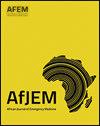Effects of a pilot simulation training on interdisciplinary closed-loop communication and time to critical actions at an emergency centre in Burundi
IF 1.2
4区 医学
Q3 EMERGENCY MEDICINE
引用次数: 0
Abstract
Introduction
Emergency medicine simulation is an effective training modality in both high and low resource settings. We describe the authors’ experiences conducting a four-week interdisciplinary, in situ, simulation training series at an emergency centre in Burundi.
Methods
Training emphasized effective closed loop communication, early airway, breathing, and circulation assessment, as well as time to vital signs, IV placement, and oxygen administration when appropriate. Six doctor-nursing teams participated in four training sessions as well as pre- and post-test simulation cases which were graded by an independent evaluator.
Results
The training resulted in a statistically significant improvement in closed loop communication as well as notable narrowing in standard deviation of times to critical actions after the training intervention. Although the small sample size and large variation of data limited their statistical significance, these results may indicate a short-term benefit towards early assessment, management and team communication when simulating management of critical patients. Additionally, we found that interdisciplinary, in situ simulation was a safe and likely beneficial option for training and team building in a resource-limited emergency centre.
Conclusion
While this pilot study establishes feasibility of low-cost, interdisciplinary emergency simulation training in resource-limited settings, further research is needed to establish educational effectiveness on quality-of-care measures and its generalizability to other contexts prior to implementing similar trainings.
布隆迪应急中心试点模拟培训对跨学科闭环通信和关键行动时间的影响
急诊医学模拟是一种有效的培训方式,无论在资源匮乏的环境下。我们描述了作者在布隆迪一个应急中心进行为期四周的跨学科现场模拟培训系列的经验。方法强调有效的闭环沟通,早期气道、呼吸和循环评估,及时观察生命体征,适当时静脉滴注和给氧。六个医生护理团队参加了四个培训课程以及测试前和测试后的模拟案例,这些案例由独立评估者评分。结果训练干预后,闭环沟通有统计学意义的改善,关键动作的标准偏差有统计学意义的缩小。虽然样本量小,数据变化大,限制了其统计意义,但这些结果可能表明,在模拟危重患者管理时,对早期评估、管理和团队沟通有短期的好处。此外,我们发现,在资源有限的应急中心,跨学科的现场模拟是一种安全且可能有益的培训和团队建设选择。结论:虽然这项试点研究确定了在资源有限的情况下进行低成本、跨学科应急模拟培训的可行性,但在实施类似培训之前,需要进一步研究以确定护理质量措施的教育有效性及其可推广到其他情况。
本文章由计算机程序翻译,如有差异,请以英文原文为准。
求助全文
约1分钟内获得全文
求助全文
来源期刊

African Journal of Emergency Medicine
EMERGENCY MEDICINE-
CiteScore
2.40
自引率
7.70%
发文量
78
审稿时长
85 days
 求助内容:
求助内容: 应助结果提醒方式:
应助结果提醒方式:


